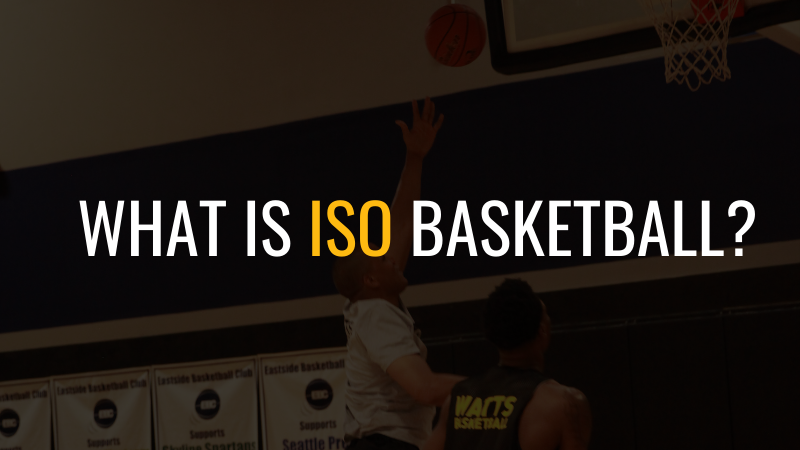Have you ever wondered what is ISO basketball? If yes, then this article will help you understand a bit more. Basketball is a team sport and the players on the court are supposed to work together for a common goal. But sometimes, some basketball players tend to compromise that cooperation and focus on individual play. There are players in the team who rely on their skills and talents for scoring baskets. These players are said to be playing with isolation.
Delve into the Hoops Lingo: What is Isolation Basketball?
Ever watched basketball and a ball handler suddenly calls for an “Iso” in a game? If so, then you have probably noticed that the offensive team would start to clear out space for the ball handler to operate. After all, “Iso” is a shortcut for isolation. To know more about this hoop term, Watts Basketball got you covered!
Definition of Isolation in basketball
In basketball jargon, ISO basketball refers to a play in which one offensive player has the ball with other offensive players nearby but not in close enough proximity to where the ball handler can pass. Once he begins his dribble or takes more than two steps (one-on-one), the remaining players may become eligible for a pass and are thus in an active position.
To create isolation, the offensive team will try to establish a low post-scoring threat before the defensive team can play aggressively. Having one player guarded by two or even three defensive players can make it easier by dragging defenders away from other potential pass receivers. One of the keys is to ensure that all defenders and especially the weak side have been kept busy on the previous offensive possession while having the ball out of bounds. If not, then a quick change to isolation play could be easily identified by watching which defenders are suddenly out of position. The slowest defender will usually become the iso defender.
Purpose of calling for isolation in basketball
A primary objective of using an isolation play is to assist the offensive team in creating a scoring chance by using a single player away from the main action of the offense, while also providing a scoring opportunity for this single player. This type of play allows the offensive team to take advantage of your weakness and exploit it (typically aggressive defenders who leave their men to help in double team situations or try and help out on jump shots instead of staying with their man).
The isolation play is extremely valuable in basketball since it often provides an open shot for a shooter. If a team has a big man who can step out and block shots, then keeping him in front of his defender can create easy lay-ins for teammates. With the NBA spread offense, many teams have shifted towards running this play since it allows for easier transition baskets.
Isolation plays are different from go-to plays in that they can be deployed at any given time. They’re designed to isolate a player without creating a lot of tempo issues for the rest of the team. In addition, isolation plays don’t require the ball handler to be simultaneously active and involved in the offense. At the same time, using an isolation play is actually quite difficult for most teams. To be successful at it, you need players who can get into the lane and create fouls in isolation; get into position to contest shots when the defense collapses on one player; and then make timely defensive decisions when their teammates run out of action.
When is the best time to call for ISO basketball
When the score is tied at the half, some players prefer to run an ISO basketball rather than pick up a second offensive rebound. Why? It gives them an opportunity to score more easily. There are two main reasons players run isolation plays. First, they want to be able to score as quickly as possible. Second, they don’t want to give up their second offensive rebound. When the score is within single digits, most players want to be as aggressive as possible on defense. That means there’s very little interest in going for offensive rebounds unless it’s an offensive foul that gives them an opportunity to score without giving up a second defensive rebound.
Another clue to execute ISO basketball is when the other team is running a play that comes in at a faster pace than your own. Even if there’s only one isolated player on your team, you should still be able to call for a play that’s not completely straight-ahead until the defense rotates. This gives the other team a chance to get into a more aggressive defensive stance before you get the ball and allows you a chance to get into a better shooting position. The key to making this play isn’t really about speed. It’s about timing and positioning. The faster you can get into position before an action is taken, the better chance you have at making a good shot.
Know how to master ISO in basketball!
Best isolation basketball plays
One of the best things about isolation basketball is just how varied it can be. You have the basic isolations, where you use one or two hands to set up your shot, but also can use one hand to simulate a step or fake, and use the other to set up a cross-court screen for a teammate or to create a passing lane.
There’s also the crossover, which although isn’t really a play in and of itself — it’s more of an observer — but is extremely effective at creating space for teammates nearby by forcing the defense to collapse on one side or the other. This is particularly effective when you have a big man who can set screens for you and take away the mid-range pull-up jumper.
There are a variety of isolation plays that are used in practice by NBA players and college players alike. A good isolation play will put the ball in the screener’s hands, make it easy for the screener to handle the ball and attack the basket, and force the defensive player to make a mistake or commit a foul. Once the offensive player gets into the spacing and looks for the shot he is most comfortable taking, it’s usually a jump shot.
How to setup ISO plays
Being able to isolate yourself well requires practice. The first step is identifying where you want to be. This could be improving your jump shot or getting better at passing. Choosing an area of improvement requires knowing the factors that will influence your progress there such as color, sight, length of time needed, etc. Once you have identified the area you want to improve, start taking small steps in that direction.
Put Iso Basketball into Practice
Isolation might not be the most glamorous play in basketball, but it is a very good way to get your best shooter an open look at the basket. It is also a great way to create opportunities for other offensive players if your opponent brings additional help to defenders.

